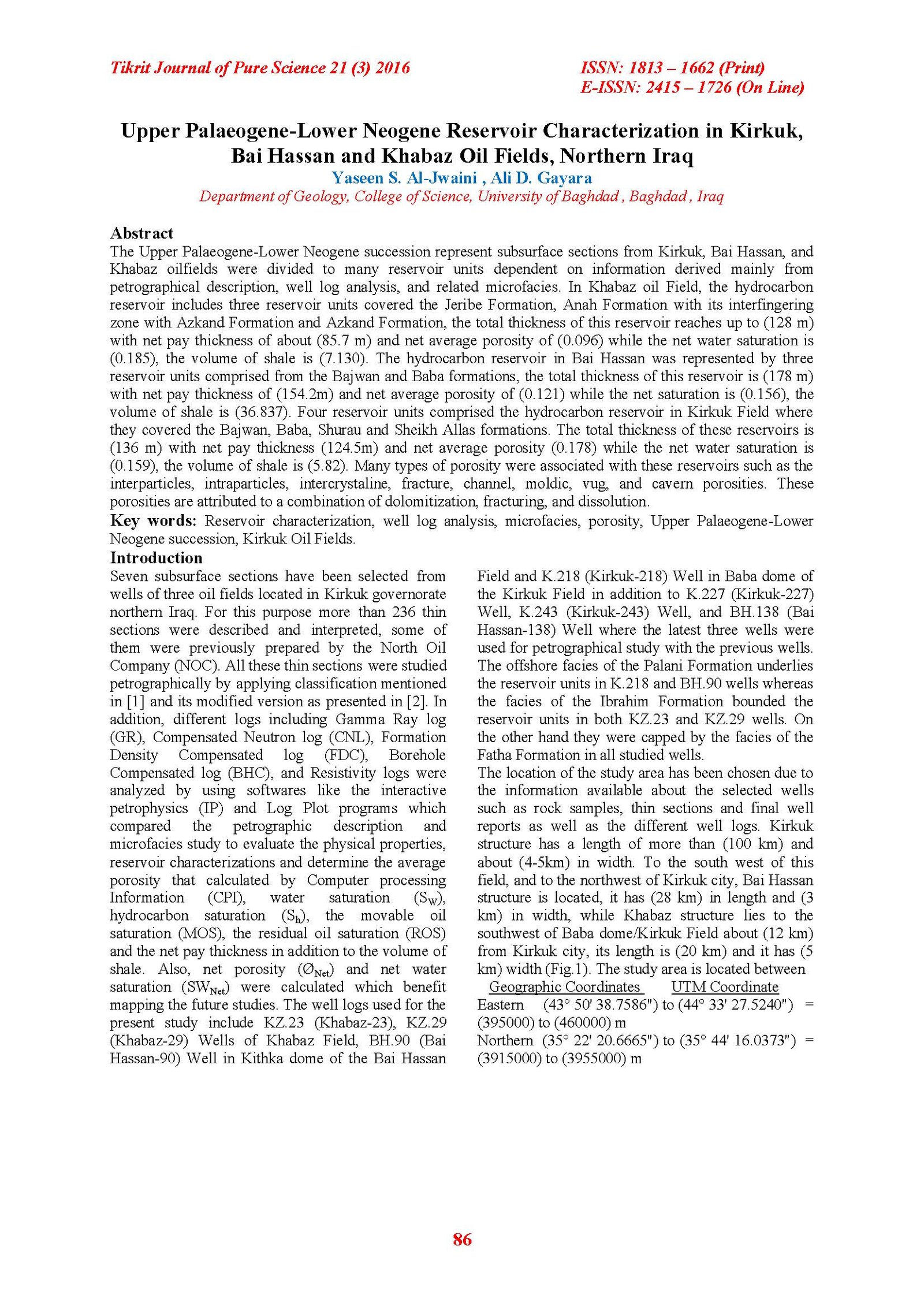Upper Palaeogene-Lower Neogene Reservoir Characterization in Kirkuk, Bai Hassan and Khabaz Oil Fields, Northern Iraq
Main Article Content
Abstract
The Upper Palaeogene-Lower Neogene succession represent subsurface sections from Kirkuk, Bai Hassan, and Khabaz oilfields were divided to many reservoir units dependent on information derived mainly from petrographical description, well log analysis, and related microfacies. In Khabaz oil Field, the hydrocarbon reservoir includes three reservoir units covered the Jeribe Formation, Anah Formation with its interfingering zone with Azkand Formation and Azkand Formation, the total thickness of this reservoir reaches up to (128 m) with net pay thickness of about (85.7 m) and net average porosity of (0.096) while the net water saturation is (0.185), the volume of shale is (7.130). The hydrocarbon reservoir in Bai Hassan was represented by three reservoir units comprised from the Bajwan and Baba formations, the total thickness of this reservoir is (178 m) with net pay thickness of (154.2m) and net average porosity of (0.121) while the net saturation is (0.156), the volume of shale is (36.837). Four reservoir units comprised the hydrocarbon reservoir in Kirkuk Field where they covered the Bajwan, Baba, Shurau and Sheikh Allas formations. The total thickness of these reservoirs is (136 m) with net pay thickness (124.5m) and net average porosity (0.178) while the net water saturation is (0.159), the volume of shale is (5.82). Many types of porosity were associated with these reservoirs such as the interparticles, intraparticles, intercrystaline, fracture, channel, moldic, vug, and cavern porosities. These porosities are attributed to a combination of dolomitization, fracturing, and dissolution.
Article Details

This work is licensed under a Creative Commons Attribution 4.0 International License.
Tikrit Journal of Pure Science is licensed under the Creative Commons Attribution 4.0 International License, which allows users to copy, create extracts, abstracts, and new works from the article, alter and revise the article, and make commercial use of the article (including reuse and/or resale of the article by commercial entities), provided the user gives appropriate credit (with a link to the formal publication through the relevant DOI), provides a link to the license, indicates if changes were made, and the licensor is not represented as endorsing the use made of the work. The authors hold the copyright for their published work on the Tikrit J. Pure Sci. website, while Tikrit J. Pure Sci. is responsible for appreciate citation of their work, which is released under CC-BY-4.0, enabling the unrestricted use, distribution, and reproduction of an article in any medium, provided that the original work is properly cited.
References
1. Dunham. R.H., 1962, Classification of carbonate rocks according to depositional texture, in W.E. Ham, ed., Classification of Carbonate Rocks, AAPG Memoir Number 1, pp. 108-121.
2. Flugel, E., 2004, Microfacies of carbonate rocks: Analysis, interpretation, and application, Springer, Berlin, 967 pp.
3. Jassim, S. Z. and Goff, J. C., 2006. Geology of Iraq. Published by Dolin, Prague and Moravian Museum, Brno. 341p.
4. Al Sayyab, A., Al Ansari, N., Al Rawi, D., Al Jassim, J.A., Al Omari, F.S., Al Sheikh,Z., 1982, Geology of Iraq, Published by Dar alkutub, Mosul University,280P. (in Arabic)
5. Choquette, P. W. and Pray, L. C., 1970, Geological nomenclature and classification of porosity in Sedimentary carbonate. AAPG. Bull., V. 54, N.2, PP. 207-250.
6. Tucker, M. E., Wright, V. P., Dickson, J., 1990. Carbonate sedimentology. Wiley-Blackwell.
7. Wilson, J.C., and McBride, E.F., 1982, Compaction and Porosity Evolution of Pliocene Sandstons, Ventura Basin, California, AAPG, Bull., V. 72, PP664-681.
8. Budd, D. A., 2002. The relative roles of compaction and early cementation in the destruction of permeability in carbonate grainstones: a case study from the Paleogene of west-central Florida, USA. Society for Sedimentary Geology, 72, 116-128.
9. Bjørlykke, K., 2010, Petroleum Geoscience: From Sedimentary Environments to Rock Physics, Springer-Verlag Berlin, 508 p.
10. Schroeder, J.H., 1988, Spatial Variation in Porosity Development of Carbonate Sediment of Rock, Facies, V.18, PP181-204.
11. Selley, R.C., 2000, Applied Sedimentology, Academic Press, 523p.
12. Al Sharhan, A.S., and Whittle, G.L., 1995, Carbonate-Evaporite Sequences of the Late Jurassic Southern and Southwestern Arabian Gulf, AAPG., Bull.,V.79, No.11, PP.1608-1630.
13. Warren, J., 2000, Dolomite, Occurrences, evolution and Economically important association, Earth Science reviews, V. 52, PP. 1-81.
14. Catuneanu, O., 2006. Principles of Sequence Stratigraphy. Elsevier, Amsterdam.375 p.
15. Asquith, G., Gibson, C., 1982. Basic Well Log Analysis for geologists: Methods in Exploration Serise, AAPG, 216p.
16. Rider, M., (2002). The Geological Interpretation of Well Logs, 2nd edition, Rider-French Consulting, Sutherland, Scotland, 280 p.
17. Doveton, J. H., 1999. Basic of oil and gas log analysis. Kansas Geological Survey, 32p.
18. Delalex, J., Boyer, S., Michaut, P., 2004, Well Log Interpretation, Total Paris La Defense, 189 P.
19. Bigelow, L., 2002. Introduction to Wireline, Log Analysis, Baker Hughes, Inc. 312P.
20. Asquith, G., Krygowski, D., 2004. Basic Well Log Analysis, 2nd Edition: AAPG Methods in Exploration Series 16. Published by The AAPG Tulsa, Oklahoma, 244p.
21. Hartmann, D.G., 1997. Gupco petrophysics workshop Cairo, Egypt.
22. Selley, R.C., 1998. Elements of Petroleum Geology, Academic Press, London, United Kingdom.
23. Inteq Baker Hughes, 1999, Geological Procedures Workbook, Baker Hughes INTEQ Training & Development 2520 W.W. Thorne Houston, TX 77073U.S.A.
24. Inteq Baker Hughes, 1999, Petroleum Geology. Baker Hughes Inteq. USA.
25. Darling, T., 2005. Well Logging and Formation Evaluation, Elsevier, Amsterdam.
26. Serra, O., 1984. Fundamentals of Well log interpretation V.1, The Acquisition of logging data. Development in petroleum science, 15A, Elsvier, Amsterdam, 440 p.
27. Krassay A. A., 1998. Outcrop and drill core gamma-ray integrated with sequence stratigraphy; examples from petrozoic sedimentary successions of northern Australia. AGSO J Geol Geophys 17, PP. 285-299.
